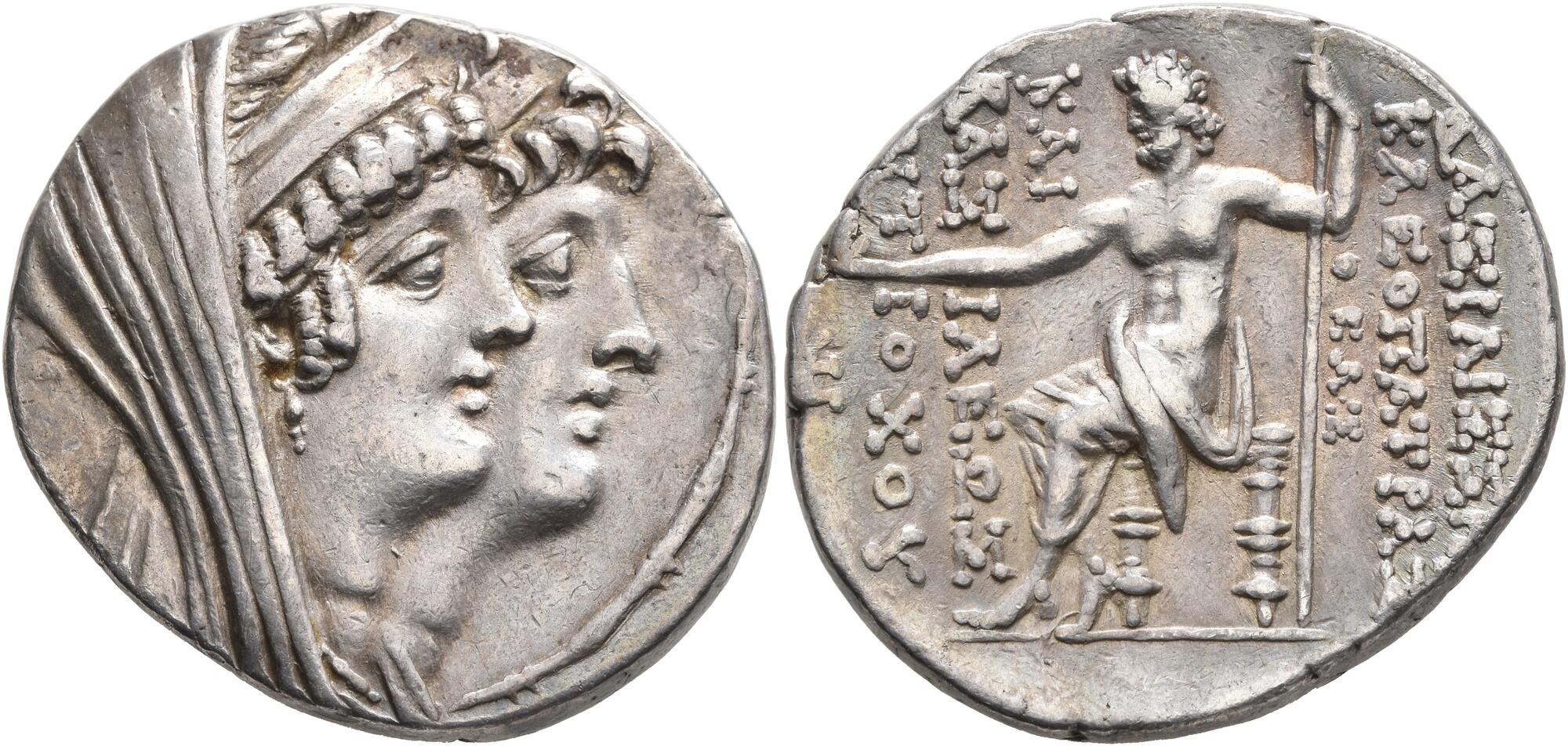Ptolemais-Ake (Cleopatra thea and Antiochus VIII), silver, tetradrachms (124-121 BCE)
From SILVER
124 BCE - 121 BCE Silver 6,105 kg
Description
| ObverseInscription or printing placed on the obverse.: | Jugate busts of Kleopatra Thea, diademed, veiled and wearing a stephane, and Antiochos VIII, diademed, to right |
| ReverseInscription or printing placed on the reverse.: | ΒΑΣΙΛΙΣΣΗΣ / ΚΛΕΟΠΑΤΡΑΣ / ΘEAΣ - ΚΑΙ / ΒΑΣΙΛΕΩΣ / ΑΝΤΙΟΧΟΥ (Greek).Zeus seated left, holding Nike in his right hand and long scepter in his left, to outer left, monogram |
Mint and issuing power
| MintIdentifies the place of manufacture or issue of a numismatic object.: | Ptolemais-Ake | Ancient regionAncient region.: | Phoenicia | Modern countryModern country: Israel | AuthorityIdentifies the issuing power. The authority can be "pretended" when the name or the portrait of X is on the coin but he/she was not the issuing power. It can also be "uncertain" when there is no mention of X on the coin but he/she was the issuing power according to the historical sources: | Antiochus VIII Grypus (Seleucid king, 121/0-97/6 BC), Cleopatra Thea (Seleucid queen, 150-121 BC), Seleucid Dynasty (312-63 BC) |
Chronology
| FromIdentifies the initial date in a range assigned in a numismatic context. | 124 BCE | toIdentifies the final date in a range assigned in a numismatic context.. | 121 BCE | PeriodTime period of the numismatic object.: Hellenistic 323-30 BC |
Physical description
| MetalThe physical material (usually metal) from which an object is made.: | Silver |
Median weightMedian of the weights of numismatic objects (in grams). in grams | 16.60 | DenominationTerm indicating the value of a numismatic object. Examples: tetradrachm, chalkous, denarius.: | tetradrachm |
StandardStandard.: | Attic |
Image

S2020 Ptolemais Cleopatra thea antiochus.jpg [1]
References
| Die study referencePublication of the study: | Voulgaridis 20001Voulgaridis 2000, p. 175-180 | ||
| Coin series referenceReference to coin series study: | SC II2SC II, n° 2271, HGC 93HGC 9, n° 1182 | ||
Obverse dies distribution
| FrequencyFrequency of specimen in distribution. ᵖ | Number of obversesNumber of obverse dies. ᵖ (o) | % (o) | Number of coinsNumber of coins. (n) | % (n) | Die nameName(s) of the die(s). |
| 1 | 2 | 11.76 | 2 | 2.02 | 2, 4 |
| 2 | 1 | 5.88 | 2 | 2.02 | 12 |
| 3 | 2 | 11.76 | 6 | 6.06 | 5, 13 |
| 4 | 2 | 11.76 | 8 | 8.08 | 3, 8 |
| 5 | 1 | 5.88 | 5 | 5.05 | 14 |
| 6 | 4 | 23.53 | 24 | 24.24 | 7, 9, 15, 16 |
| 8 | 1 | 5.88 | 8 | 8.08 | 11 |
| 9 | 1 | 5.88 | 9 | 9.09 | 6 |
| 11 | 1 | 5.88 | 11 | 11.11 | 1 |
| 12 | 2 | 11.76 | 24 | 24.24 | 10, 17 |
| Total | 17 of 17 | 99.97 | 99 of 99 | 99.99 |
Reverse dies distribution
no distribution is available
Quantification
| Number of obversesNumber of obverse dies. ᵖ (o) | 17 | Number of singletons (o1)The number of singleton coins. ᵖ | 2 |
| Number of reverse diesNumber of reverse dies. (r) | 67 | Number of coinsNumber of coins. (n) | 99 |
| Coins per obverse dieNumber of coins per obverse die. (n/o) | 5.82 | Coins per reverse dieNumber of coins per reverse die. (n/r) | 1.48 |
| Reverse per obverse ratioRatio of obverse dies divided by reverse dies. (r/o) | 3.94 | Percentage of singletons (o1)number of coins (n) divided by the number of singletons (o1) ᵖ | 11.76 % |
| Original number of dies (O) (Carter 1983 formula)The estimation of the number of coins according to Carter 1983 ᵖ | 18.39 | Coins struck if 20,000 as average productivity per dieCoins made if the average productivity for obverses (according to Carter) is 20,000. ᵖ | 367,800 |
| Original number of dies (O) (Esty 2011 formula)The estimation of the number of coins according to the singleton formula in Esty 2011 ᵖ (O) | 20.52 | Survival rate if 20,000 as average productivity per dieSurvival rate if average productivity is 20,000. ᵖ | 0.00027 |
| Coverage (o = % of O) (Esty 1984 formula)Esty 1984 - coverage (% of O) ᵖ (o = % of O) | 97.98% | Die productivity if survival rate 1/2,000Average productivity if survival rate is 1/2,000. ᵖ | 10,766.72 |
| Weight of silver (in kg) if 20,000 coins per die (O = Carter formula)Carter 1983 * Median weight * 20000 (*10 if gold or electrum) ᵖ | 6,105 kg <br /> 6,105 kg | Die productivity if survival rate 1/5,000Average productivity if survival rate is 1/5,000. ᵖ | 26,916.8 |
Remarks
Most likely one single workstation